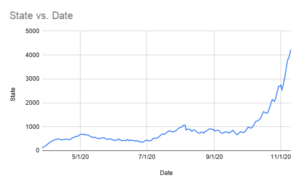I’ll be candid, I haven’t read this entire document, but it seemed worth sharing: 2020 ISDH Emergency Response Report (pdf). I found the link in the minutes to the October 14, 2020, interim committee on public health. I guess I would have expected that entire meeting to be devoted to COVID and making recommendations to the General Assembly on legislation to address the pandemic which is currently spiraling out of control. (But, the legislature isn’t exactly nimble – the agenda and the notice of the committee meeting were probably prepared a month before based on planning which happened before that. In August, the pandemic felt kind of stable.)
Anyway, what I found probably most interesting in the ISDH document (at p. 18) was a chart of suspended, waived, or modified rules and statutes. For example, a prohibition on automated dialing was suspended for the purpose of allowing the Fairbanks Study to call people to determine the extent of COVID spread. There are several pages of these modified rules, allowing more remote services, modifying timelines, and relaxing rules to account for the fact that more resources are being thrown at COVID. The document also has a chart (p. 13) listing reduced or suspended health services (e.g. audiology assessment services were reduced or changed to virtual, routine food safety inspections were suspended, some immunization services were suspended, etc.).
As far as future recommendations, the report suggested to the General Assembly:
Related to ongoing response operations and other pre-COVID public health initiatives, IDOH recommends that Indiana consider a long-term solution for expanding some telehealth services on an ongoing basis. The temporary expansion during the COVID-19 pandemic has proven to be invaluable in supporting healthcare delivery during the public health emergency when our healthcare system was facing challenges keeping patients and providers connected, especially for patients with chronic medical conditions or circumstances where a patient did not feel safe with a traditional face-to-face visit or in-home services. Delivery of services through telehealth expands access to care, streamlines efficiency and increases convenience for both patients and provider and is expected to be an improvement in service delivery going forward.
Which is fine, as far as it goes. What I wonder is whether the committee on public health or some other arm of the General Assembly is studying masking, social distancing, and other tools for limiting the spread and damage caused by the pandemic and — probably the important part — how best to obtain public buy-in and compliance with such requirements or recommendations.
